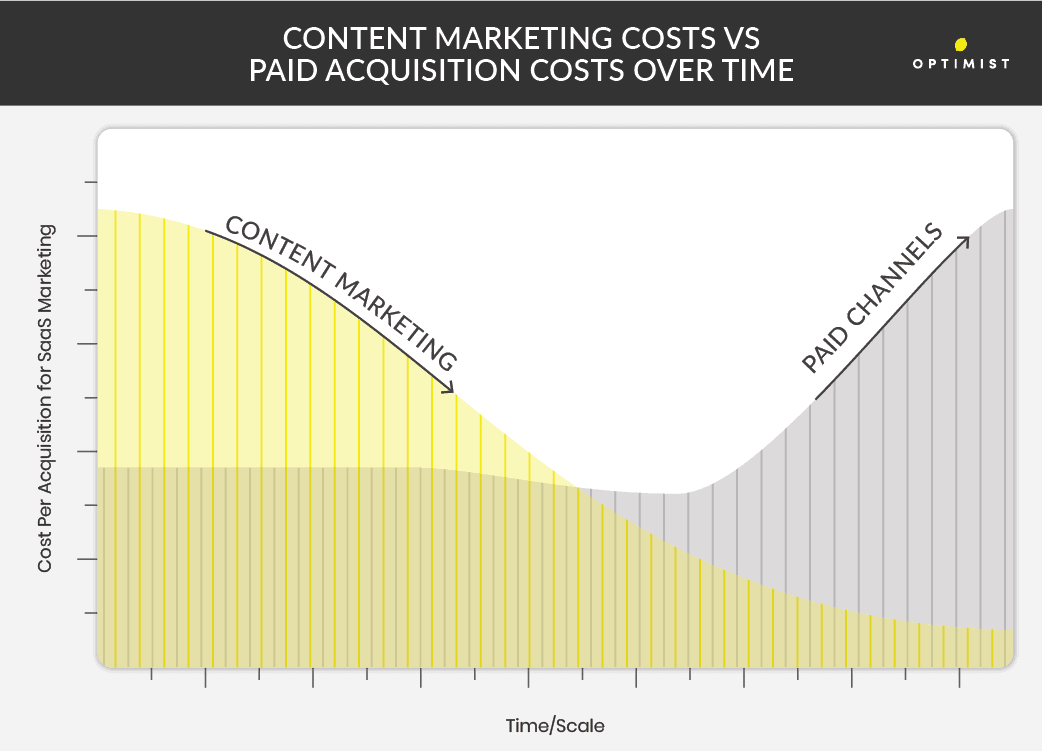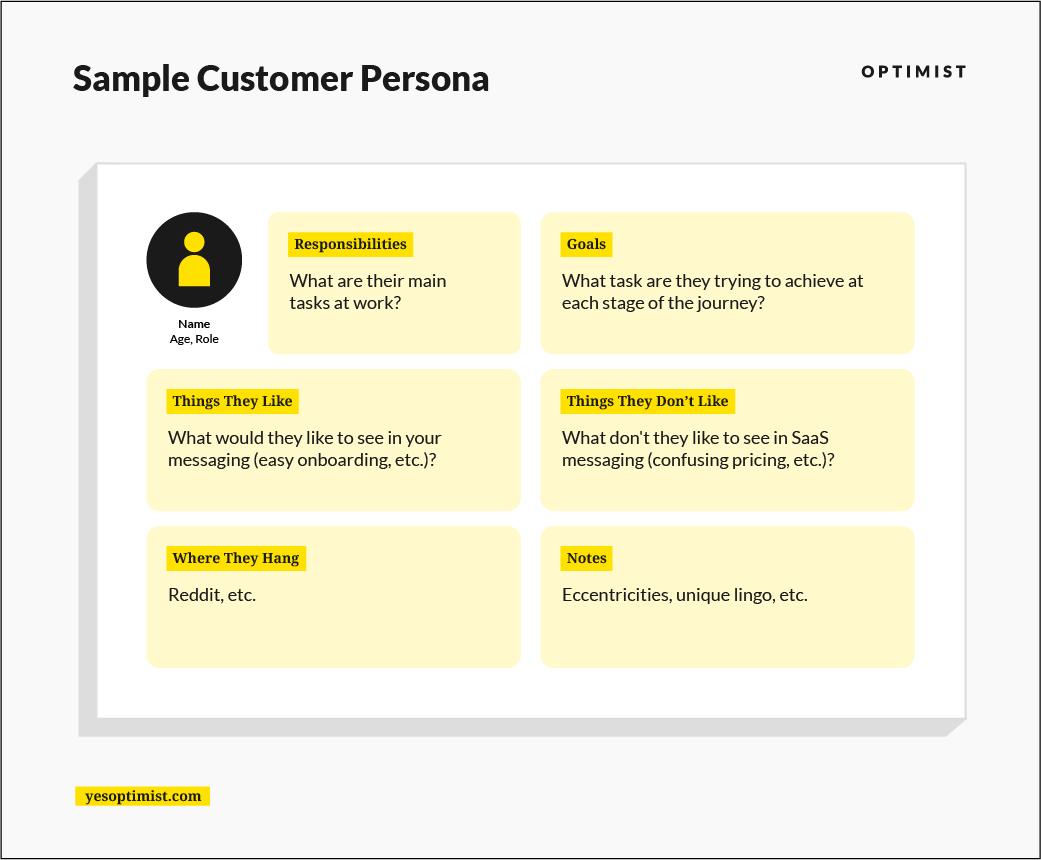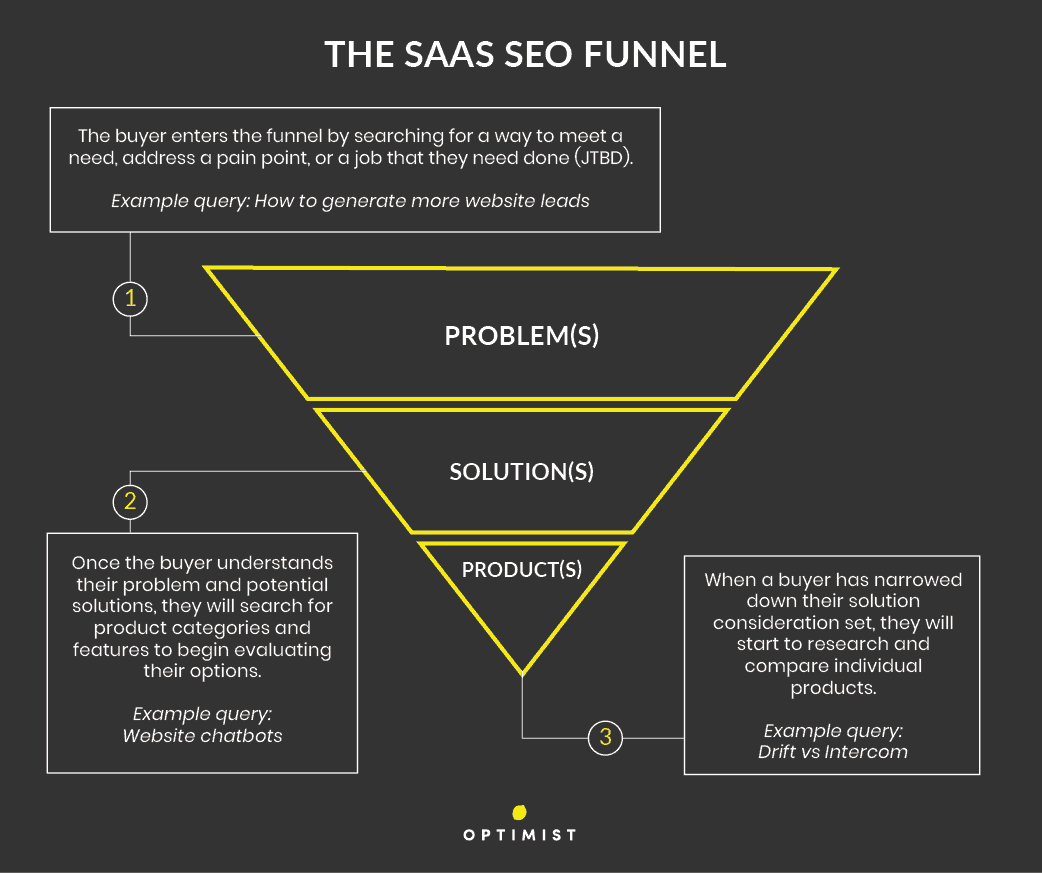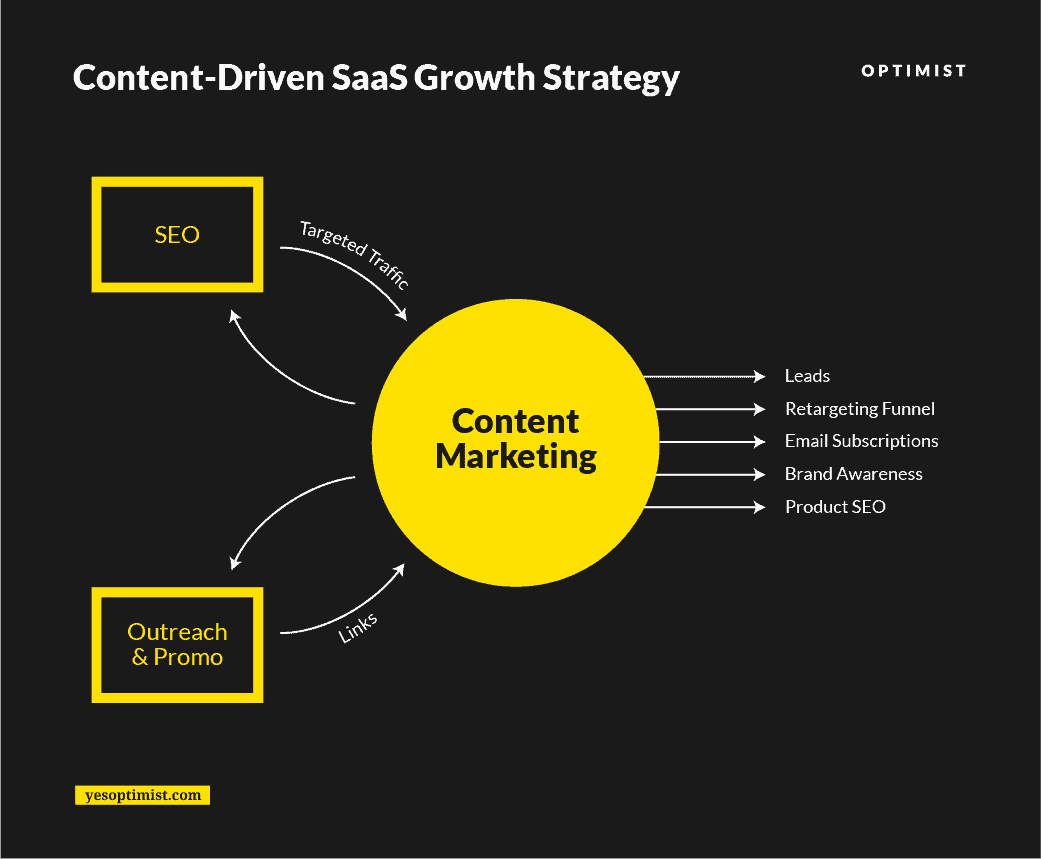No matter where your company exists in the SaaS space, most marketing and business leaders share a common goal: to get more people discovering and signing up for their services.
Ideally, without paying an arm and a leg for traffic that may or may not even convert.
Think that’s a big ask?
Sounds like your inbound marketing could use a little tuning up.
Whether you’re already attempting inbound digital marketing — and not seeing much movement yet — or still feeling it out for your own organization, here’s what you need to know to create a content-powered SaaS inbound marketing engine that revs up sales.
What Does Inbound Marketing Look Like?
First, a marketing history lesson. (I’ll keep it short — promise.)
The term “inbound marketing” is thought to have been coined by HubSpot co-founder Brian Halligan in the early 2000s.
Up until then, marketing was mostly what’s now come to be known as “outbound marketing.”
In this traditional marketing approach, companies reach out to potential customers using methods like radio, print, and TV advertisements; direct mail; phone calls; and paid search and social ads. Since these tactics aim to connect with everyone and anyone, they tend to generate leads who are cold, or initially unaware of your brand. This makes for a higher rate of attrition and requires a lot more work to go from lead ➡️ customer.
Inbound marketing on the other hand uses content to invite interested potential customers into a brand’s universe. This content can take almost innumerable forms — website content and branding, landing pages, on-site blogs, guest blogs, white papers and ebooks, videos, podcasts, email marketing campaigns, webinars, etc. These efforts are often boosted by search engine optimization (SEO), which is an ongoing process for improving the experience consumers have when interacting with your content and the platforms where your content lives.
As you can see, instead of injecting itself into the conversation with people who may or may not be interested, inbound marketing builds resources that attract like-minded potential customers into a business’ circle — aka, warm leads! These market-qualified leads (MQLs) should be able to drop right into your sales cycle and work their way toward conversion without tons of education or handling.

Why Pursue SaaS Inbound Marketing?
Alright, so we just threw a whole new marketing approach at some of you.
We understand if you need a little more time, and a lot more data-backed reasoning to take to your decision-makers, before you’re ready to go all-in on inbound marketing.
We’ll walk you through those tactical steps later on when you are ready to take the plunge — we have a lot of faith in inbound, obvi. But first, we’ll explain the reasoning behind why every SaaS business should add a content-based, inbound element to their marketing methodology.
Research Finds Inbound = Eyeballs
According to HubSpot’s 2022 report State of Inbound Marketing Trends, direct traffic is the second largest source of website traffic according to more than 1,600 marketers.
Turns out, there really is power in building a brand that the right people can relate to — instead of trying to annoy them into submission with 15 back-to-back podcast ads featuring the sweet sounds of air horns.
But what’s the number one channel for traffic generation?
Organic search is the single biggest source of website traffic, pulling in close to 30% of traffic.
(Organic search traffic is basically website visits that come from unpaid search engine results.)
Research by growth leader and friend of Optimist Mike Sonders backs up this finding. According to his own deep dive, organic search is typically the most productive source of traffic, new visitors, and leads for some of the biggest SaaS companies in the U.S. For some of those businesses, it can drive as much as 77% of their overall traffic.
After video-based content, blogging is the most popular marketing format for the marketers in HubSpot’s Survey.
That right — it’s all about content-driven inbound marketing, bay-bee.
So while we’re riding that high, let’s go ahead and talk about a few other reasons to make the inbound pivot.
Paid Leads Only Flow as Long as Your Cash Does
Over time, it takes more effort and more money to acquire new customers via paid means, such as pay-per-click (PPC) digital ads.
Why? Well, between new competitors bursting onto the scene and the exhaustion of the audiences that were most likely to convert, you’re going to have to work harder and pay more to rise to the top.
So unless you’re willing to pay more and more to play, it’s likely that leads from paid sources will dry up as soon as your cash flow does.
However, content-driven inbound marketing is actually the complete opposite.
If done right, you should expend the most time and money in the early days. Planning, creating, and putting all your inbound marketing systems into place may take months. And honestly, it might take another few months before you start to see the payoff from all that hard work. But once you’re generating traffic and optimizing your efforts, you’ll be able to enjoy the result of all that labor — a steady stream of well-aligned leads.
After the initial investment is made, content is a resource that can be used over and over again with minimal, in other words affordable, upkeep. As your inbound marketing leads grow over time, the cost of each customer acquisition will only dilute further.

Diversify Acquisition Channels Like You Diversify Finances
In the finance world, diversification is the process of adding a wide range of asset types to your portfolio so if any one asset type drops in value, your whole portfolio won’t also tank.
Your business might have also diversified across product lines, or even target audiences, to balance out risk in the same way.
So why wouldn’t you do the same when it comes to marketing?
This is where we need to acknowledge that outbound marketing isn’t necessarily a bad approach, it’s just not enough in today’s super competitive and swiftly-changing SaaS environment. Adding another method, such as inbound marketing, into the mix just increases your opportunities to connect with the right potential customers.
Own, Don’t Rent With Inbound
If you’ve ever been a housing renter, you may understand how scary it can be when the owner of your property needs to raise rent, sell, or change the terms of the engagement.
What’s even scarier is how many businesses don’t recognize that they are renters on the platforms where they’ve built their entire marketing identity.
Outbound marketing assets (think ads) are often built on and hosted within social media channels and search engines. That’s rented land. At any time, the owners of these platforms could change their algorithms, drastically raise their prices, or make their rules prohibitive. And just like that, there goes all your marketing progress.
By supplementing your outbound efforts with content-based inbound efforts that you ultimately own — even when they’re shared to LinkedIn or Apple Podcasts — you keep the power to use your resources however you see fit.
Plus, when you use your content to bring traffic to your owned channels, such as your website, your investment feeds back into your platform instead of some giant, third-party platform.
6 Steps to Building a SaaS Inbound Marketing Strategy Around Content
Data visibility is getting harder and harder as businesses and entire countries crack down on data collection for marketing purchase.
And you know what, we’re all for everyone being able to choose the privacy level that works best for them!
But what that means from a business perspective is that we’ve all had to let go of optimizing single marketing touches. The future of successful marketing lies in your ability to create valuable content that delivers at every stage of the buyer’s journey.
You can do it. Just come along as we cut through the noise and dive right into the tactics of building a B2B SaaS inbound marketing strategy that fires on all cylinders.
Step 1: Set Your Inbound Marketing Goals, KPIs, and Tactics
The first step in creating an effective inbound strategy revolves around knowing what you want it to achieve. Having clear goals will not only help you maintain focus but also prevent others within your organization from pulling you off track with ✨ helpful ✨ new ideas.
Goals, objectives, or whatever you want to name them may look like:
- Generating clicks on a specific link in your newest ebook
- Increasing number of leads coming through your demo request form
Next, in order to determine how you’re progressing on goals and when a goal has been fully met, you want to make sure you have very specific key performance indicators (KPIs) in place that outline what success looks like.
For the above goals, these may be some helpful KPIs to track:
- Number of ebook downloads
- Number of clicks on your target link
- Number of people visiting the demo request form
- Number of people completing that form
Finally, how will you make progress on those KPIs and achieve your ultimate inbound marketing objectives? Only by enacting specific tactics.
This process really highlights the value in being flexible and experimental with content-based inbound campaigns. There are likely going to be lots of different marketing tactics that could help you meet your goals. You’re only going to exhaust your resources if you try all of them at once. Instead, prepare to be iterative, trying new tactic/KPI combos if you aren’t quite seeing the performance you want.
But, back to tactics. For the example we’ve been working with so far, some of your tactics might include:
- Including your target link 2x on every page of the ebook
- Using enticing anchor text and design elements to generate more clicks on your target link
- Driving traffic to the demo request form in every blog post this quarter
- Optimizing the demo request form to align with cutting-edge website usability standards
- Making the link to your demo request form page more accessible from your website home page

Step 2: Define Your Audience and the Channels Where They Hang Out
This step is highly related to the last one, since your goals, KPIs, and tactics will certainly be influenced by your target audience and the channels they use to engage with your content.
For example, if the type of person you’re trying to reach is highly resistant to entering their contact information on an internet form, that goal around generating more demo request form entries will need to look different.
However, since this step has plenty of work associated with it, we think it’s best to tackle it separately. Just be sure to go back to step 1 again when you’re done here to make sure everything meshes.
The task at hand is two-fold. What we’re doing right now is:
- Defining the audience — or audiences — you want to draw to your business with your content
- Identifying all the places they hang out, so you can share and promote your content in those spaces
The discoveries made here should all be documented in what’s called a buyer persona.

A buyer persona is a generalized profile that highlights all the important details about your ideal customer. Personas help humanize the people you’ll be serving your inbound marketing to, ensuring that you use language, channels, and promotional tactics that move them to action.
Where should you get the information you need to create buyer personas?
- Identify real people who are already engaging with your marketing and fall into your target audience, then research them to identify their job roles, characteristics, and habits.
- Interview your existing audience one-on-one to learn more about them, or conduct surveys to collect this information.
Since we wrote an entire guide about how to create awesome buyer personas here, we won’t reinvent the wheel in this article. Just remember you want to include:
- Basic demographic data + role
- workplace responsibilities
- Work goals
- Any eccentricities associated with their role
- Where they engage with content related to their role
- The kinds of brand messaging they do and don’t connect with

Step 3: Plan Content Around Buyer Journey + SEO Research
Where in their buying journey are your audience members — and what search terms are they using at each stage to find content that meets their needs?
To answer this, first you must apply what you know about your audience to the different stages of the marketing and sales funnel so you can create content that delivers maximum value.
At Optimist, here’s how we envision the SaaS inbound marketing funnel, along with what types of content add the most value in each stage:
- Top of Funnel (TOFU) — The Problem Stage: In this stage, the searcher is looking for answers to their pain points. They aren’t looking for specific product recommendations as much as they are for content around strategies, data, and maybe input from experts.
- Middle of the Funnel (MOFU) — The Solution Stage: Here, the searcher has some problem-solving options in mind, and is searching for the right type of SaaS product. This is where you’ll create guides around your type of platform, features readers should prioritize, etc.
- Bottom of the Funnel (BOFU) — The Product Stage: Your searcher is ready to choose a product. It’s time to really show off your SaaS with specific product comparisons, case studies, integration guides, etc.
Now that you know what kinds of content to deliver to your audience no matter where they are in their customer journey, it’s time to make sure they’re finding that content. This is where SEO comes in.
SEO is all about improving where your content shows up when someone from your audience uses a search engine. If you sell SaaS in the photo sharing industry, you want your blogs to show up at the top of the page when someone Googles “what’s the best digital photo sharing tool?” That’s what SEO aims to do.
Mostly, this is done through keyword optimization. That means using keywords that match up with how your audience naturally searches. In the above example, the keyword may have been the phrase “photo sharing tool.” If you create content that naturally uses this and related keywords, you have a better chance of getting in front of your audience’s eyeballs!
When you’re ready to dive deep into everything you need to know about SaaS SEO strategy, read our full guide here.
But to get you going down the right path in the meantime, here are some ideas for identifying the keywords your content should revolve around:
- Brainstorm: Start easy — make a huge list of terms you think your audience is searching for.
- Ask around: Talk to customer service, sales, and your own buyers. See what kinds of phrases they’re using right now.
- Competitive research: Learn what other SaaS businesses in your space are writing about.
- Google Trends: See how many searches certain phrases are getting over time, and where.
- Semrush: This platform can help with keyword research, creating content ideas, and beyond.
- Ahrefs: Another platform for keyword research and more (we love this one here at Optimist).
Now you have all the information you need to develop what’s called a content plan. This is the actual document, usually in calendar form, that lays out what topics you’re going to cover and how it’s all going to interlink to best meet your audience’s needs throughout the funnel — and fulfill the marketing goals you’ve set.

Step 4: Execute on Content Creation
Isn’t it funny how one of the most crucial steps on this list is one where we really don’t have all that much to say?
Simply put, it’s time to execute! There’s nothing left to do but put your head down and work. You finally get to create and publish the SaaS inbound marketing materials that will bring together everything you’ve learned in this guide so far.
While you do so, here are some tips to hold on to:
- Stay aligned with the keywords and topics you just developed for your content plan
- Don’t forget those overarching inbound marketing goals and KPIs we put into place earlier
- You know your target audience and channels — speak to them
- Are you using SEO best practices? You’ll want to stay abreast of these as they change over time, but here are some updated writing tips from SEJ
- Remember you can (and will) iterate, so done is better than perfect right now
Step 5: Build Out Your Content Marketing Promotion Network
The truth is, there’s a little bit of outbound marketing at the heart of all this inbound marketing strategizing we’re doing.
We call it content promotion (aka promo).
This is different from distribution.
Distribution stops at just publishing your content to various channels. While this is certainly a wise practice to help spread its reach, it’s not quite enough.
Promotion requires putting in that extra effort to create content that’s always been meant for a specific channel, to become an embedded part of the communities where you share your content to increase engagement, and to build relationships with other marketers so you can create value for each other through reciprocal sharing. For us, it’s important enough that we have a whole team dedicated to doing this job at Optimist.
Not promoting content is one of the leading reasons we see inbound marketing efforts fail. It’s a loud world, you have to do a little more than just rank near the top of Google’s search engine results page. You have to shout back.
There are lots of really fun ways to approach content promotion. Here are some of our faves:
Social Channels
Yes, you can just post your new YouTube tutorial to your Facebook page or chop your newest article into slides for Insta, but has that really been having the impact you want it to?
Social is a great place to start spreading your promo wings since you’re likely already pretty familiar with how it works. Become a member of industry groups that encourage you to share your content, connect with other businesses in your industry and share content on each other’s pages, look for popular curation resources and get your content on the list, etc.
Pay to Play
OK, OK so we were a little harsh on paying for leads earlier, but that’s only because we wanted to make it super clear that paying for leads alone isn’t a sustainable marketing approach.
But a little cash injection from time to time to boost your social reach? Love that for you (and us).
It doesn’t have to cost a lot to get your newest piece of content in front of thousands on the big social platforms. The caveat here is that you better make sure that content is laser-focused on the audience you’re paying to get in front of, or it won’t have the conversion rate impact you’re looking for.
Influencer Outreach
Influencers are subject-matter experts (SMEs) and tastemakers in specific niches. Getting someone with influence in the SaaS space, or more specifically your industry, to share your content is an excellent way to generate qualified leads.
This could be another pay-to-play situation, because even influencers can’t survive on exposure alone. However, it may not have to be. If you’re looking to save money and have time for the long game, start developing and nurturing relationships with smaller influencers. Eventually, you should be able to establish enough rapport, and provide enough value, to ask for a favor in the form of a share.
Digital Communities
Subreddits, Twitter hashtags, Facebook groups, brand-hosted spaces — the internet is full of communities where like-minded people gather to discuss hobbies or solve problems. And if your content speaks to one of them, you’re in a great spot as far as promo opportunities go.
However, and this is very important, these tight-knit groups can usually smell advertising from a mile away. That means it’s best if you can ingrain yourself into the group, do nothing but add value, and carefully follow any rules they have for content sharing and brand promotion.
Link Building
Getting links back to your website and/or specific pieces of content (these are called backlinks) is a powerful strategy for organic traffic and lead generation.
Then why don’t more people participate in this process known as link building? Because doing it right takes a good amount of time and a lot of humility.
Good link building looks like finding websites or pieces of content that you think aligns with something you’ve already created, reaching out to their owners, and asking them nicely to insert a link to your resource.
And that strategy just barely scratches the surface. There is a whole world of linking building practices out there. If you’re ready to dive deep, read Brian Dean’s exhaustive link building strategies guide.

Step 6: Measure, Reoptimize, and Do It All Over Again
Alas, there is no rest for the weary SaaS marketer.
For now that you’ve done all of the above planning, creating, and promoting — it’s time to do it all again.
Because while we’re certain that your work is solid, it can always be improved with new input.
The first step here is to track how your finished inbound marketing content is performing in comparison to the goals and metrics you set out for it in the beginning.
In addition, here are some other tools for measuring effectiveness:
- Google Analytics:This tool will inform you how different pages on your website are performing as far as traffic goes.
- Google Search Console: You know those keywords you’re aiming to rank for? This will show you the actual phrases that are bringing traffic to your site and where you rank for each.
Next, use what you learn to optimize existing content as well as come up with fresh ideas for the next quarter. Reoptimizing content using fresher keywords to make it even more targeted is one of the most affordable ways to grow traffic while lowering churn and cost of acquisition.
Regular content refreshments are a critical part of the inbound marketing strategies we deploy for clients at Optimist, to make sure their content is always working for them.
Your Next Move: Hire An Inbound-Focused Dream Team
More than 80% of marketing teams told HubSpot they think it’s more effective to create high-quality content, not a high quantity of content.
We know that’s true.
What we can’t be so sure about is how many of you reading this have the time, the resources, or the driving passion it takes to research, plan, create, promote, and refresh high-quality content.
But we can bet it’s not a whole helluva lot.
And that’s OK.
In fact, that’s why Optimist exists.
As a SaaS content marketing agency, we’re crazy about partnering with SaaS orgs large and small to 5x, 10x, and even 30x inbound marketing traffic with content.
Ready to have someone else drive your SaaS inbound marketing strategizing and execution for a change — or soup up what you’ve already got?
Then it’s time you start working with us.